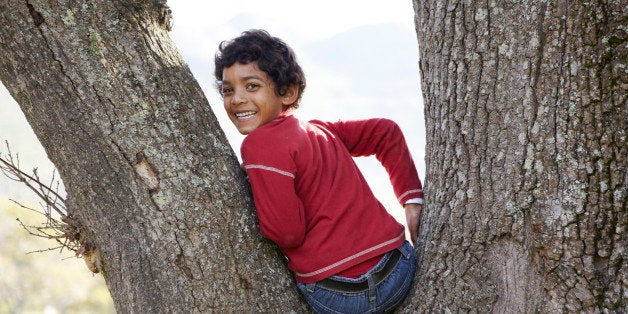
I was walking in Central Park last week when I noticed a small crowd had gathered and were pointing to something in the sky. I couldn't make out what they were looking at, but I passed a woman and she muttered to no one in particular, "I sure hope his mother comes quickly!"
Then I saw the object of their concern. A boy, perhaps 11 or 12 years old, was climbing a tall tree and was about 30 feet up. What I found remarkable was that this group of strangers considered a boy up a tree to be so, well, remarkable. Sure, what he was doing was risky. But there was calculation in his every move and a certain grace in his swift ascent. I realized that for some of the younger kids, whose parents and nannies were tightly holding their hands, this was a sight they had never seen before, nor an experience they were ever likely to be allowed to do.
It got me thinking about our risk-averse culture and how this heightened sense of concern has affected everything from our parenting styles to the laws we pass to keep kids safe, both in the "real" world and on the Internet.
But safe from what? Keeping kids safe from harm is different than ensuring an avoidance of risk. In certain circumstances, risk can be good. Being exposed to some danger or the possibility of something bad happening and overcoming that situation leads to a wonderful sense of achievement, builds confidence and most importantly, resilience in ourselves and in our kids.
I recently went white water rafting with my teenage daughter and I had to sign a disclaimer that included the line, "This activity can be dangerous and may lead to injury or death." I happily signed it, knowing that with a life jacket, some initial training and an experienced guide, we'd be doing something risky, but provided we followed instructions and not do anything foolish, we wouldn't come to any harm.
In the online world, there are a number of risks that our kids encounter. There is the possibility of exposure to porn or other inappropriate content. There is a very small chance of a malicious stranger making contact and trying to lure them away. Our kids risk being bullied online as much as they do offline. And there are inherent risks to our children's privacy and reputation, not to mention the potential of having their identity stolen.
But let's keep in mind that a risk is different from real harm. And, as the tech journalist Larry Magid recently noted, we tend to overestimate the potential risks of young people -- from privacy to bullying -- when adults can be just as susceptible and possibly less protective of their personal information or more likely to bully others online than their own kids.
If we are to create policies and pass laws, let them be on the basis of actual harm. And let us craft legislation or rules that are based on quantifiable evidence and not the latest headline or magazine survey. And while it is important to protect our kids, it is as important to empower them to report abusive comments or bullying, to be an "upstander" and not a bystander to hurtful behavior online.
And, as parents, we need to keep our fears and worries in check -- staying calm and responding in a measured manner when our kids tell us of what they've seen or done online that's upset them. Our biggest challenge is not to overreact, but to use these situations as teachable moments and take the opportunity to jointly explore how they could respond right away, or what steps they can take in the future to ensure this kind of harmful situation doesn't arise again.
And then, perhaps, you could encourage your kid to go outside and climb a tree. Safely, of course.